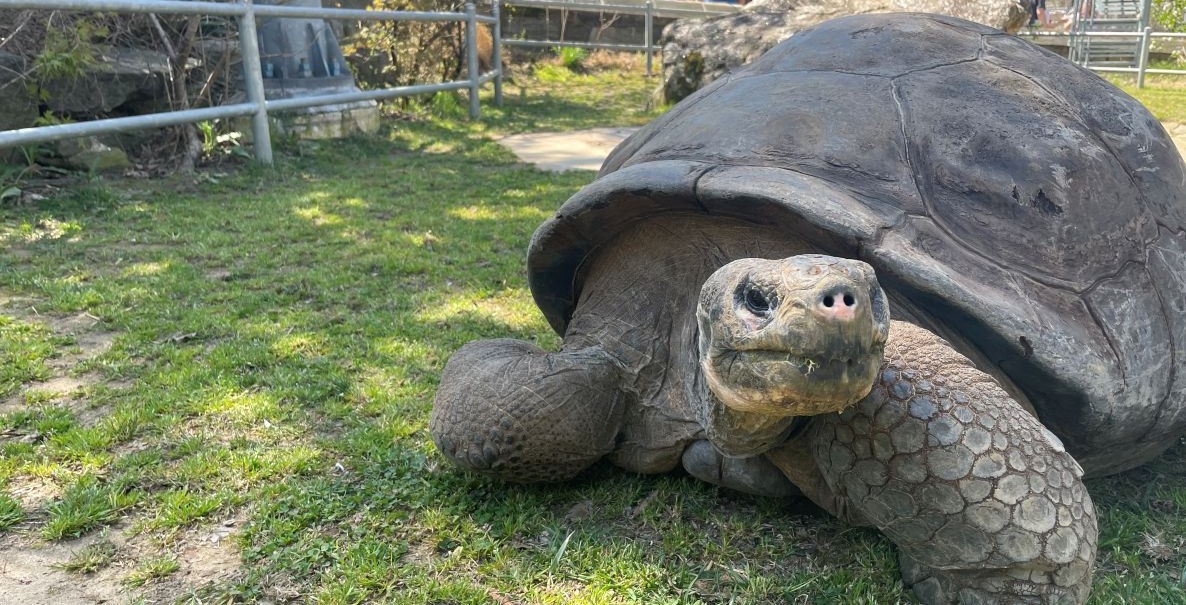At around 97-years young and with wrinkly grey skin, Mommy, a Galápagos tortoise and the Philadelphia Zoo’s oldest resident, might not look like much. But she’s actually very eligible.
Mommy is one of the most genetically valuable Western Santa Cruz Galápagos tortoises in North America. Since 2022, the zoo has been trying to breed her in an effort to help preserve the species. These efforts are part of the Association of Zoos and Aquariums Species Survival Plan, which helps preserve the genetic diversity of species, like Galápagos tortoises, that are endangered.
Listen to the interview edition here:
There are only around 20,000 giant tortoises from 12 distinct species in the wild. Until this month, there were just 44 Western Santa Cruz giant tortoises in North America. Then, the much-hoped-for happened: Mommy fell for Abrazzo, the zoo’s male Western Santa Cruz Galápagos tortoise, whom she met in 2022.
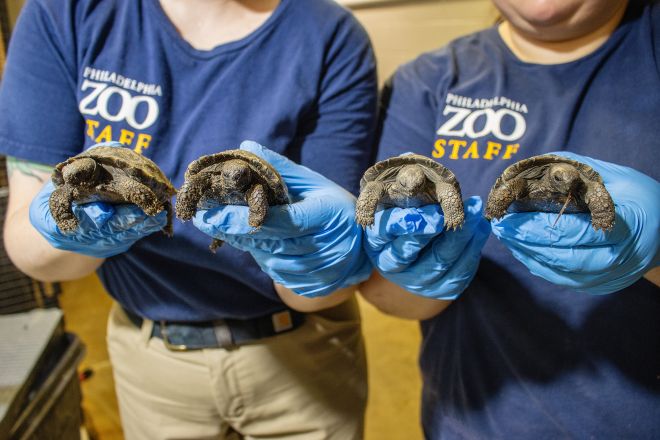
In 2023 she started laying eggs for the first time in decades. After three unviable rounds, this month, Mommy’s latest batch of eggs hatched and four baby tortoises were born.
The babies will make their public debut on April 23, the 93rd anniversary of Mommy’s arrival at the Zoo. They’re the first Galápagos tortoises to be born in the zoo’s history. More will hopefully follow soon.
Tinder for tortoises
Abrazzo was brought to the zoo to begin the process of breeding with Mommy in 2020. The Association of Zoos and Aquariums Species Survival Plan had identified that Abrazzo, who was then residing at the Riverbanks Zoo and Garden in Columbia, S.C., would be a good mate for her.
The two are both classified by the plan as “genetically valuable,” meaning that they have strong genes and that their genes are variable from one another. Both are wild-caught tortoises, so they don’t share lineages with tortoises that have been bred and have grown up in captivity. Abrazzo was also a “proven male,” says herpetologist Lauren Augustine, curator of reptiles and amphibians at the Philadelphia Zoo, because he’d fathered babies before. In 2011, he became the father of five hatchlings at the Riverbanks Zoo.
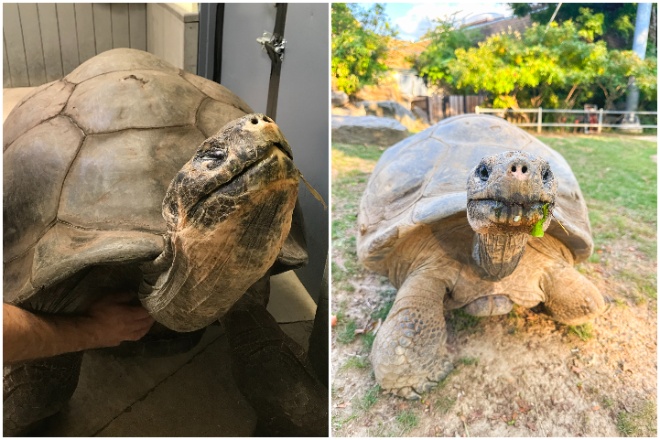
Though the zoo knew Mommy and Abrazzo would be a good genetic match, they couldn’t breed right away. The zoo needed to renovate the tortoise habitat to include a mound, where Mommy would likely lay her eggs (she did). They also wanted to add more pools and natural dividers. Abrazzo is 410 pounds and Mommy is only 285 pounds. Zookeepers were concerned he’d come on too strong and stress Mommy out, so the zoo wanted to give them some additional space.
“It was really important for Mommy to be able to navigate and be able to control her interactions as much as possible with Abrazzo,” Augustine says. Tortoises, they’re just like us.
Once the two met in 2022, animal behaviorists observed them to see if Abrazzo was paying attention to Mommy, or the other female tortoises in the habitat. (These tortoises are a different species, but they can mate. Decades ago, before Abrazzo came to the zoo, Mommy met and mated with a giant tortoise of a different species.)
Thankfully, Mommy and Abrazzo took to one another. Behaviorists tracked that he spent more time with her than the other female tortoises in the enclosure. They mated and Mommy laid eggs. Female Galápagos tortoises need male sperm to produce eggs where babies can develop. But they can store male sperm in their bodies for several years before it fertilizes their eggs. So it was unclear whether baby tortoises would develop in Mommy’s eggs until the zoo’s herpetologists could test them.
Caring for tortoise eggs
Once Mommy laid her eggs, zookeepers collected them and brought them to an artificial incubation space. There, they checked them for viability using a process known as candling. They shine light into the eggs to check for development. It’s usually clear if eggs are viable about 10 days after they’re laid, Augustine says. They can also check for viability if an egg is “chalking,” where the top of the shell becomes slightly transparent, so scientists can track development without using a light.
In November, when Mommy laid her fourth batch of eggs, zookeepers were optimistic. She hadn’t laid cycles of eggs for a while and it isn’t uncommon for it to take a few rounds before any eggs are viable. Augustine came in on November 21 and saw seven eggs were developing.
“We were like, oh, my God, this one’s developing,” she says. “It was really exciting to start seeing those signs.”

Augustine has been at the zoo since 2022. She’s been a herpetologist for more than 20 years, working at institutions like the Smithsonian, the Saint Louis Zoo and the Wildlife Conservation Society. She grew up in the Philly area and her love of amphibians and reptiles started with her father. He was an amateur naturalist who would take her out to look for snakes and frogs. She remembers they once had turtles in their bathtub.
“All of our careers started somewhere, but most likely, it was with an interaction with a live animal.” — Lauren Augustine
Once Augustine and her team knew the eggs were in good shape, they divided them into two different incubators, set at different temperatures. Gender selection for Western Santa Cruz Galápagos Tortoises is determined by temperature. Eggs incubated at a higher temperature will be female and those incubated at a lower temperature will be male. This is becoming a problem for tortoises in the wild because over the next 50 years, climate change is expected to increase temperatures in the Galápagos Islands by 1 to 4°C. So, over the next several decades, scientists expect there to be more female tortoises and fewer males.
“Climate change is a big threat to them,” Augustine says.
Female tortoises develop more quickly because they’re incubated at higher temperatures, so Mommy’s first four hatchlings are all female. They have three male eggs they expect to hatch soon as well.
Meeting the hatchlings
The baby tortoises have an “egg tooth” that they use to break open their shells in a process called “pipping.” The first hatchling started pipping mid-day on February 27. Augustine was out of town, but her team called to tell her the news. The hatchlings continued pipping until March 6.
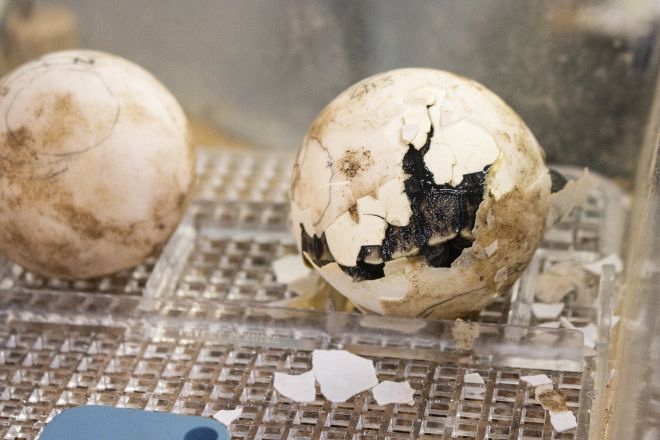
The hatchlings are about the size of a tennis ball. They’re living behind the scenes in the zoo right now — they can’t be in the tortoise habitat as, at between 200 and 400 pounds, the adults could crush them. They have a habitat with a pool and they are practicing climbing. When zookeepers come to feed and check on them, they’ll practice defensive behaviors, tucking their heads into their shells.
“It’s really adorable,” Augustine says. “We try not to bother them too much, but we make sure that they’re eating and soaking and growing appropriately.”
The babies will still be separated from Mommy, Abrazzo and the other giant tortoises when they make their public debut. They’ll be housed in a habitat in the Reptile and Amphibian House. Galápagos tortoises reach their full size when they’re 20 to 25 years old.
“It’s a big responsibility raising a giant tortoise that’s going to live 200 years,” Augustine says. “It starts now with good health and good veterinary care and good nutrition.”
A step for species conservation
The Philadelphia Zoo is one of 240 U.S. zoos that work together to breed endangered species. The Philadelphia Zoo has played a critical role in preserving species like Cuban Crocodiles by preserving genetics that no longer exist in wild populations. They’re currently working on a breeding program to reintroduce the Guam Kingfisher bird. If the Philadelphia Zoo gets eggs from the bird, they will go to the Sedgwick County Zoo for hatching and then will be released to the tropical forests in the Palmyra Atoll.
Mommy’s hatchlings will be at the Philadelphia Zoo for at least five years, but after that they might move to other zoos. The zoo will share details about how visitors can help choose names for the babies closer to when they make their public debut on April 23.
“It’s a big responsibility raising a giant tortoise that’s going to live 200 years. It starts now with good health and good veterinary care and good nutrition.” — Lauren Augustine
The babies won’t reach sexual maturity for decades, but some zoos want to gain experience rearing and studying juvenile tortoises. When they reach sexual maturity, they may move again if they’re a good genetic match for other Western Santa Cruz Galápagos Tortoises.
“It will be a group effort to decide where and when animals are moved and why,” Augustine says.
Right now, breeding efforts for Western Santa Cruz Galápagos tortoises at U.S. zoos are centered around protecting the genetic diversity of the North American population. There are breeding efforts in the Galápagos for reintroduction, so the North American population acts as a genetic backup of sorts, in case something happens to the tortoises who are already on the island.
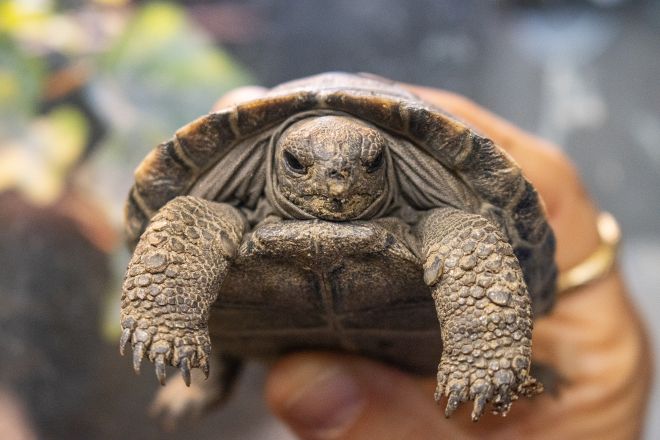
Maintaining this genetic variability is important because Western Santa Cruz Galápagos tortoises are threatened in the wild. There aren’t a ton of them and natural disasters can wipe out large numbers of tortoises. “Island species can be devastated very quickly by natural disasters because they are small, isolated populations,” Augustine says.
Breeding efforts also help raise awareness. Mommy’s babies have been featured everywhere from The New York Times to Saturday Night Live. A writer for Vogue lamented that she kind of wants to be Mommy — or at least envies her reproductive longevity. At around 97, Mommy is firmly in middle age for her species, which can live up to 200 years in captivity. So she’s also part of a trend of older moms.
All of this media attention — and the flock of visitors who will likely come to the zoo to see Mommy and the babies — helps raise awareness about the species and their endangered status. Seeing the tortoises can also inspire people to pursue research careers that can help protect species in the future.
“All of our careers started somewhere, but most likely, it was with an interaction with a live animal,” Augustine says. “Whether it was in a zoo or a nature center or out in our backyards, something sparked us to drive into this field and help contribute to conservation.”
![]() MORE ANIMAL WONDERS FROM THE CITIZEN
MORE ANIMAL WONDERS FROM THE CITIZEN



